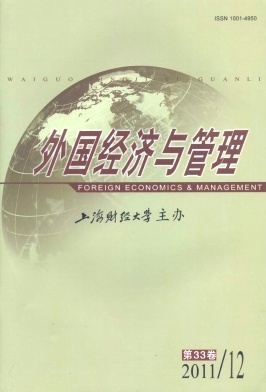组织退耦理论研究综述及前沿命题探讨
外国经济与管理 2011 年 第 33 卷第 12 期, 页码:18 - 25
摘要
参考文献
摘要
组织退耦研究是近年来组织制度扩散理论研究的一个新方向,相关研究试图回答为什么各组织要素的呈现状态会出现逻辑上的割裂,哪些因素可能导致组织退耦的发生,隐藏在组织退耦现象背后的作用机制又是如何的,等等。而国内学界对这一理论的新进展关注甚少。本文从退耦的内涵、成因、分类以及前因变量等方面对这一领域的相关文献进行了系统的梳理,进而提出了组织退耦研究的三大前沿命题,并进行了适当的讨论。
“制度距离”是国际商务领域在分析母国和东道国之间的制度环境差异时所提出的一种分析构念(Mudambi和Navarra,2002;潘镇等,2008)。
[1]Abrahamson E.Managerial fads and fashions:The diffusion and rejection of Innovations[J].Academy of Management Review,1991,16(3):586-612.
[2]Ansari S M.Made to fit how practice vary as they diffuse[J].Academy of Management Review,2010,35(1):67-92.
[3]Beverland M and Luxton S.Managing integrated marketing communication(IMC)through strategic decoupling:How luxury wine firms retain brand leadership while appearing to be wedded to the past[J].Journal of Advertising,2005,34(4):103-116.
[4]Brunsson N.The organization of hypocrisy:Talk,decision and actions in organizations[M].New York:John Wiley&Sons,2002.
[5]Elsbach K D and Sutton R I.Acquiring organizational legitimacy through illegitimate actions:A marriage of institutional and im-pression management theories[J].Academy of Management Journal,1992,35(4):699-738.
[6]Fiss P C and Zajac E J.The diffusion of ideas over contested terrain:The(non)adoption of a shareholder value orientation among German firms[J].Administrative Science Quarterly,2004,49(4):501-534.
[7]Fiss P C and Zajac E J.The symbolic management of strategic change[J].Academy of Management Journal,2006,49(6):1173-1193.
[8]Haunschild P R.Interorganizational imitation:The impact of interlocks on corporate acquisition activity[J].Administrative Science Quarterly,1993,38(4):564-592.
[9]Kostova T and Roth R.Adoption of an organizational practice by subsidiaries of multinational corporations[J].Academy of Ma-nagement Journal,2002,45(1):215-233.
[10]Lounsbury M.Institutional sources of practice variation:Staffing college and university recycling programs[J].Administrative Science Quarterly,2001,46(1):29-56.
[11]Meyer J W and Rowan B.Institutionalized organizations:Formal structure as myth and ceremony[J].American Journal of Soci-ology,1977,83(2):340-363.
[12]Oliver R L.Satisfaction:A behavioral perspective on the consumer[M].New York:McGraw-Hill,1997.
[13]Orton J D and Weick K E.Loosely coupled systems:A reconceptualization[J].Academy of Management Review,1990,15(2):203-223.
[14]Westphal J D and Zajac E J.Substance and symbolism in CEOs’long-term incentive plans[J].Administrative Science Quarter-ly,1994,39(3):367-390.
[15]Westphal J D and Zajac E J.The symbolic management of stockholders:Corporate governance reforms and shareholder reactions[J].Administrative Science Quarterly,1998,43(1):127-135.
[16]Westphal J D and Zajac E J.Decoupling policy from practice:The case of stock repurchase programs[J].Administrative Science Quarterly,2001,46(2):202-228.
[17]Zucker L G.The role of institutionalization in cultural persistence[J].American Sociological Review,1977,42(5):726-743.
[18]陈扬.组织制度扩散理论研究评介与整合模型构建[J].外国经济与管理,2011,33(5):41-48.
[1]Abrahamson E.Managerial fads and fashions:The diffusion and rejection of Innovations[J].Academy of Management Review,1991,16(3):586-612.
[2]Ansari S M.Made to fit how practice vary as they diffuse[J].Academy of Management Review,2010,35(1):67-92.
[3]Beverland M and Luxton S.Managing integrated marketing communication(IMC)through strategic decoupling:How luxury wine firms retain brand leadership while appearing to be wedded to the past[J].Journal of Advertising,2005,34(4):103-116.
[4]Brunsson N.The organization of hypocrisy:Talk,decision and actions in organizations[M].New York:John Wiley&Sons,2002.
[5]Elsbach K D and Sutton R I.Acquiring organizational legitimacy through illegitimate actions:A marriage of institutional and im-pression management theories[J].Academy of Management Journal,1992,35(4):699-738.
[6]Fiss P C and Zajac E J.The diffusion of ideas over contested terrain:The(non)adoption of a shareholder value orientation among German firms[J].Administrative Science Quarterly,2004,49(4):501-534.
[7]Fiss P C and Zajac E J.The symbolic management of strategic change[J].Academy of Management Journal,2006,49(6):1173-1193.
[8]Haunschild P R.Interorganizational imitation:The impact of interlocks on corporate acquisition activity[J].Administrative Science Quarterly,1993,38(4):564-592.
[9]Kostova T and Roth R.Adoption of an organizational practice by subsidiaries of multinational corporations[J].Academy of Ma-nagement Journal,2002,45(1):215-233.
[10]Lounsbury M.Institutional sources of practice variation:Staffing college and university recycling programs[J].Administrative Science Quarterly,2001,46(1):29-56.
[11]Meyer J W and Rowan B.Institutionalized organizations:Formal structure as myth and ceremony[J].American Journal of Soci-ology,1977,83(2):340-363.
[12]Oliver R L.Satisfaction:A behavioral perspective on the consumer[M].New York:McGraw-Hill,1997.
[13]Orton J D and Weick K E.Loosely coupled systems:A reconceptualization[J].Academy of Management Review,1990,15(2):203-223.
[14]Westphal J D and Zajac E J.Substance and symbolism in CEOs’long-term incentive plans[J].Administrative Science Quarter-ly,1994,39(3):367-390.
[15]Westphal J D and Zajac E J.The symbolic management of stockholders:Corporate governance reforms and shareholder reactions[J].Administrative Science Quarterly,1998,43(1):127-135.
[16]Westphal J D and Zajac E J.Decoupling policy from practice:The case of stock repurchase programs[J].Administrative Science Quarterly,2001,46(2):202-228.
[17]Zucker L G.The role of institutionalization in cultural persistence[J].American Sociological Review,1977,42(5):726-743.
[18]陈扬.组织制度扩散理论研究评介与整合模型构建[J].外国经济与管理,2011,33(5):41-48.
引用本文
陈扬, 许晓明, 谭凌波. 组织退耦理论研究综述及前沿命题探讨[J]. 外国经济与管理, 2011, 33(12): 18–25.
导出参考文献,格式为:
上一篇:规制俘获理论最新进展述评
下一篇:“组织领导力发展”内涵探讨





 6367
6367  526
526

